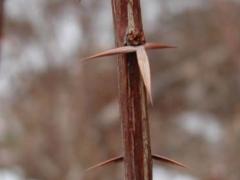Invasive Species: Berberis vulgaris, Common Barberry
Common barberry is an invasive deciduous shrub that can reach 13 ft. (4 m) in height. The leaves, which occur in clusters of two to five, are oval, 3/4 in. to 2 in. (2 to 5 cm) long, 1/4 to 3/4 in. (1 to 2 cm) wide, and serrate. Each cluster of leaves is subtended by a short, three-branched spine. Flowering occurs in May to June, when yellow flowers that are less than 1/4 in. (6 mm) wide develop in panicles. Berries are red, oblong, and less than 1/3 in. (10 mm) long. Common barberry is native to central and southern Europe and occurs in shaded areas.
What are invasive species, and why should we be concerned about them?
Taxonomy: Scientific and Common Names for This Species
Ranunculales > Berberidaceae > Berberis vulgaris L
Synonym(s): beet, epine-vinette, epine-vinette commune, European barberry, vinettier
Berberis vulgaris – USDA PLANTS Profile
Distribution Maps
common barberry – The reported distribution of this invasive species across the United States (Source: Invasive Plant Atlas of the United States)
Up-to-the-minute distribution maps and why they are important
Reporting This Invasive Species
What is the best way to report the occurrence of an invasive species?
How to report an invasive species sighting to EDDMapS – Early Detection & Distribution Mapping System
EDDMapS – Report an invasive species to EDDMapS.
County Extension Offices – Find your county Extension office on this map provided by USDA.
How to Identify
This invasive species can be identified by looking for the characteristics described in the paragraphs that follow.
Shrub
Common barberry is an invasive deciduous shrub that can reach 13 ft. (4 m) in height.
 |
 |
| Robert Videki, Doronicum Kft., bugwood.org | Leslie J. Mehrhoff, University of Connecticut, bugwood.org |
Foliage
The leaves, which occur in clusters of two to five, are oval, 3/4 in. to 2 in. (2 to 5 cm) long, 1/4 to 3/4 in. (1 to 2 cm) wide, and serrate. Each cluster of leaves is subtended by a short, three-branched spine.
 |
|
| Leslie J. Mehrhoff, University of Connecticut, bugwood.org | bugwood.org |
Flower
Flowering occurs in May to June, when yellow flowers that are less than 1/4 in. (6 mm) wide develop in panicles.
 |
|
| Leslie J. Mehrhoff, University of Connecticut, bugwood.org | bugwood.org |
Fruit
Berries are red, oblong, and less than 1/3 in. (10 mm) long.
 |
|
| Steve Hurst, USDA NRCS PLANTS Database, bugwood.org | bugwood.org |
Native Species That Resemble Common Barberry
– Images at invasive.org
| bugwood.org | bugwood.org |
– Images at invasive.org
| bugwood.org | bugwood.org |
Additional Images for Common Barberry
common barberry – Images at invasive.org
Learning Resources for Common Barberry
Berberis vulgaris Identification Card – U.S. Fish and Wildlife Service
Berberis vulgaris Fact Sheet – U.S. Fish and Wildlife Service
Additional Information, Biology, Control and Management Resources
Control and management recommendations vary according to individual circumstances. Location, habitat, weather, and a variety of other conditions are factors that help determine the best treatment choice. To find the safest and most effective treatment for your situation, consult your state’s land-grant institution. If you will use chemicals as part of the control process, always refer to the product label.
United States Land Grant University System – Find your Land Grant University’s College of Agriculture, University Cooperative Extension Service, or other related partner on this map provided by USDA.
Invasive Plant Atlas of New England – University of Connecticut
Weed of the Week – USDA Forest Service
Fire Effects Information System – USDA Forest Service
DCNR Invasive Plant Tutorial – Plant Conservation Alliance, Alien Plant Working Group
